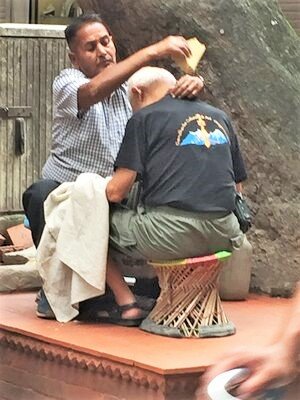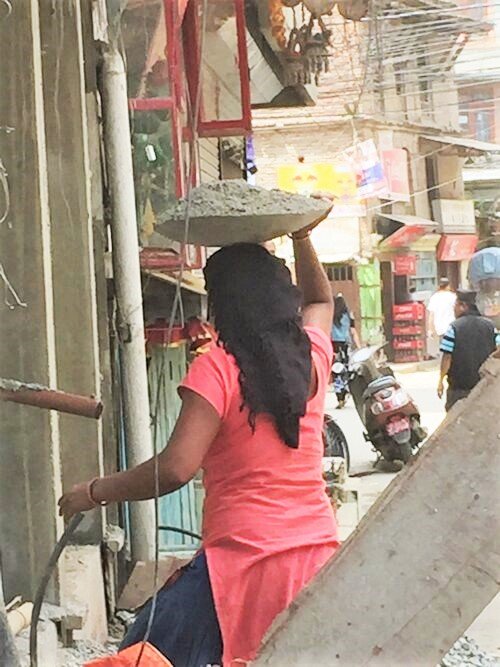vaga #6/3 Walking in Thamel
PART II
Walking through Thamel, means after assimilating such visual, acoustic bombardments, hallucinating with the crafts and told myself; -in other times I would buy everything-,try new foods, new codes, etc ... already past that impression come the details that appear to the eye once accustomed to so much information, emotion and lowering the revolutions. The characters, the routines of the locals and one begins to recognise them as such, those who have always been there, but one already begins to see them. And that's where I talk about the times in each place, going in and out I spent more than two months in Thamel and the details appear among other things, such as friendships, festivities ... waking up and walking through Thamel must be read together because one is inside the other, they are part of a single space of just over 10 by 20 blocks.
photos always with dust in suspension and if there are people with masks, it is not because of the pandemic, it is because of pollution, the story takes place in 2018. It should be said that Thamel in the 60s was a hippie enclave, with a "freak zone" and from there it began to be known before tourism for trekking would take a priority. Of that "freak zone" and hippyism there is absolutely nothing left. Thamel was founded with the palace of the royal in 1069 which today remains in Durbar Square, a World Heritage Site.
leaving the first day from an alley I came across the first ascetic I have seen, there are ascetics in several religions, these are Hindus, they walk slowly, alone, in the mornings, they do not see many, they go with a well, they go through the shops and say nothing, they give them food and sometimes cash. Everyone does, respects them and even admires them. Ascetics are a personal determination to seek spirituality by freeing themselves from all material and family ties.
Thamel, it's not just about tourism, that's a rather new part and not very big, there's a lot of commercial movement. There are no vans to make the deliveries of supplies, so everything is carried on the shoulder, or on curious bicycles and creatively adapted to the need of the product being transported.
hundreds and hundreds of small places that sell everything, in certain streets for tourists, they sell handmade clothes, a lot of cashmere, carpets, handicrafts in wood, metal, masks, antiques, musical instruments, images of goddesses with precious stones. A huge variety of sports shops, trekking. Peter went crazy to see so many backpacks, shoes, and clothes like "north face", very cheap, as well as for example, "dry fit" t-shirts for 10 dollars, versus 100 in Chile, feather parkas the same, and all kinds of supplies for trekking. It would be about 5 blocks full of these things in amongst the sale of vegetables and fish.
added to what is described above we must add the bustle of walkers and vendors. Between shops are the small enigmatic altars, some just an image attached to a wall, others were left in the middle of an alley and the street is diverted around them, women praying, others putting candles, incense......
several trades are carried out spontaneously, the corner next to a temple is the hairdresser who appears in the afternoons or the shoemaker who works in the mornings, under an improvised roof, seamstresses, wood craftsmen, stonemasons, and painters .....
there are no cars, no noise, no horns, no traffic, no unpleasant noise pollution that is very pleasant. It caught my attention that young men walked embracing and holding hands, nothing to do with homosexuality, it is a fraternity
you can not think of Thamel today without taking into account the earthquake of 2015, which collapsed, being the oldest area of the city. It took almost two years to start rebuilding since everything was done with international help, and that takes time to coordinate where the money goes, which is the most urgent and so on. Thamel is under reconstruction and the finished buildings are beautiful, respecting its architecture and especially those carved in wood. Buildings under repair or those that are still semi-grounded are well protected from the public. You still see destruction, stacking of bricks, many houses and temples with external pillars of reinforcement. It is working in many places, both private and government buildings, I was struck by women doing hard physical work, so far I have only seen that only in Myanmar.
wood carvings: I loved the doors, all have carvings, from the most modest to those of the royal palace. Some with religious iconographies, symbols of protection, there are skulls, goddesses, some with tremendous eyes, snakes or simply a geometric drawing, I never saw them repeated. It should be noted that the work of the artisans is extraordinary. I saw outside Thamel in a neighbourhood that there were workshops and boys were carving with the point of chisel and hammer with remarkable skill, unfortunately, I passed by twice in a taxi and could not stop to see their masterful techniques, as the patterns follow, in short, it is a tradition, and they continue to work fully on that. Not only is Thamel part of Nepalese architecture, but the carvings also go from lintels, balconies, pilasters, shutters, window lattices.
Some of what's behind the doors, intimacy is seen. Through open Doors you can see how they eat, altars, small restaurants without much light, or televisions there the locals eat, the rest of Southeast Asia lives outside, eats and cooks on the street, on the pavements and here is the opposite, it would not be appropriate for one to enter those places, I only went once I was invited by some friends, and it was in an alley of labyrinths and narrower no more than a meter wide, I alone would never get in and with them, I went in, and we ate.
these bikes are used to transport people, most are tourists and some locals also cross into Thamel. They are all very old and some in a decadent state, each one is decorated in its own way, with plastic flowers, umbrellas, scarves ...
“costumes”; men's clothes, here they do not wear sarongs -the skirt-, as in almost all Southeast Asia, women mainly wear sarees, these shops are far from the tourist area.
design of bicycles that are adapted for their specific needs and the last photo a unique spawn as a "pickup truck" with a tractor type engine, they use it to carry heavy construction material.
always thinking about chaos, streets with crowds others calmer, pray, making prayers, at all times of the day, find the spiritual space and stop in front of an altar, give offerings, ring the bells, this goes on every time, several times in the busiest blocks, most are Hindu, but there are also Buddhist monasteries where you pray inside.
this is how a day ends in Thamel,........... Tired















































































































